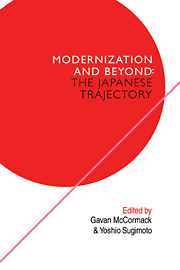Book contents
- Frontmatter
- Contents
- Contributors
- Introduction: modernization and beyond
- I Popular culture: tradition and ‘modernization’
- II Popular movements: alternative visions of ‘modernization’
- III Uneven development and its discontents
- 6 The other side of Meiji: conflict and conflict management
- 7 Nuclear power and the labour movement
- 8 Street labour markets, day labourers and the structure of oppression
- IV Sex, politics and ‘modernity’
- V ‘Modernization’ and ‘modernity’: theoretical perspectives
- Glossary
- Index
7 - Nuclear power and the labour movement
Published online by Cambridge University Press: 04 August 2010
- Frontmatter
- Contents
- Contributors
- Introduction: modernization and beyond
- I Popular culture: tradition and ‘modernization’
- II Popular movements: alternative visions of ‘modernization’
- III Uneven development and its discontents
- 6 The other side of Meiji: conflict and conflict management
- 7 Nuclear power and the labour movement
- 8 Street labour markets, day labourers and the structure of oppression
- IV Sex, politics and ‘modernity’
- V ‘Modernization’ and ‘modernity’: theoretical perspectives
- Glossary
- Index
Summary
ECONOMIC BACKGROUND
The most severe over-production crisis in Japan hit the economy between 1974 and 1975 and this was accompanied by sudden price rises caused by the ‘oil shock’ of autumn 1973. Technically, such a phenomenon is known as a ‘structural depression’. As a result of this economic crisis, a ‘rationalization’ policy, also called an ‘adjustment of employment’ policy was adopted in almost all sectors of industry. Irrespective of the name, this was nothing but the retrenchment of large numbers of employees. It included a significant reduction in new recruitments, resort to temporary lay-offs and voluntary retirement, reduction of over-time work, the retrenchment of seasonal and part-time workers and the cutting down of large numbers of day labourers. Industries also took various measures to reduce investment in production plants and machinery and to economize by amalgamating or dissociating affiliated companies.
The people hit most severely by this ‘rationalization’ were temporary workers and day labourers at the bottom of the Japanese industrial structure, who subsequently found difficulty in finding work. In 1960 temporary workers and day labourers made up 12.5 percent of the total Japanese workforce. In 1973 this figure rose to 17 percent; reflecting the rapid economic expansion. However, in 1975, when the economic recession following the first oil crisis hit its bottom, this figure fell to 14.4 percent. It should be noted also that the largest group of unemployed temporary workers and day labourers was and still is those people of middle age or more.
- Type
- Chapter
- Information
- The Japanese TrajectoryModernization and Beyond, pp. 129 - 146Publisher: Cambridge University PressPrint publication year: 1988
- 1
- Cited by



